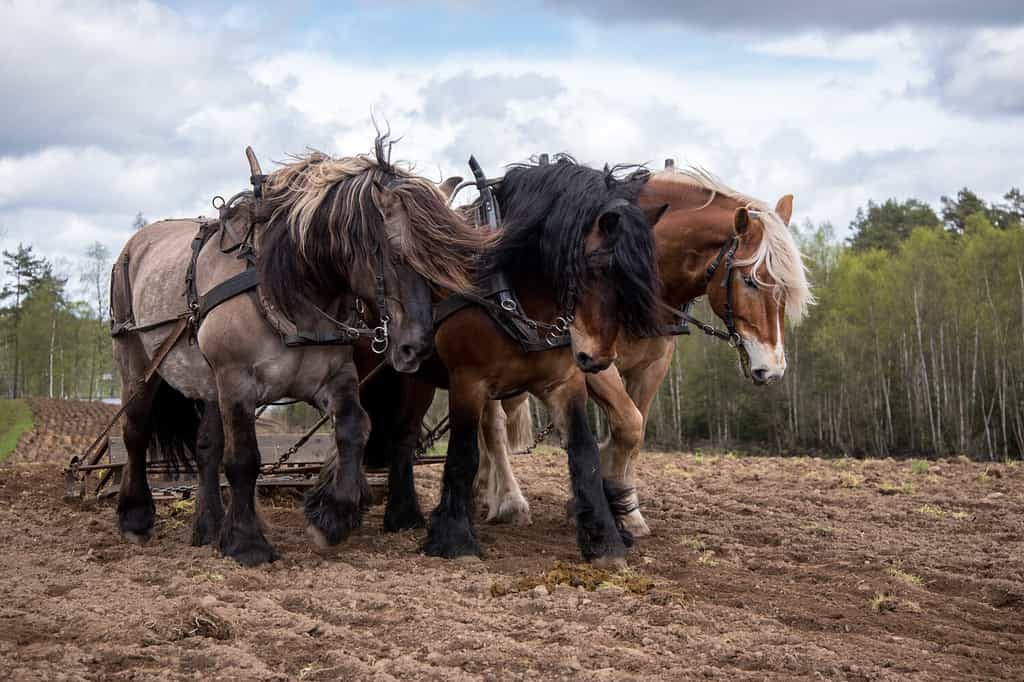Horses possess incredible strength that has been harnessed by humans for centuries. In this article, we delve into the fascinating world of equine power, exploring just how much weight a horse can carry and pull. Prepare to be amazed by their extraordinary capabilities!
How Much Weight Can a Horse Pull?

How much weight a horse can pull depends on whether it is dead weight or a wheeled item.
©Sylvie Bouchard/Shutterstock.com
When it comes to pulling heavy loads, horses showcase an impressive display of strength. Typically, a horse can pull approximately 1/10 of its body weight in “dead weight,” which refers to objects like sleds or fallen logs that do not offer any additional assistance. However, when wheels are added to the load, such as placing a log on a cart, the average horse’s pulling capacity increases significantly. In fact, they can pull around 1.5 times their own body weight with relative ease.
Interestingly enough, shorter distances seem to activate an even more astounding level of power within these magnificent creatures. Depending on the breed and individual athleticism, horses have been known to effortlessly exert themselves by pulling up to six times their own body weight for brief periods.
It is truly remarkable how equine strength can be harnessed in different scenarios and circumstances. From assisting farmers in plowing fields to aiding in transporting heavy materials over short distances – these incredible animals continue to awe us with their immense power and unwavering determination.
Factors That Influence How Much Weight a Horse Can Pull

A team of draft horses can pull a large amount of weight.
©Annelie Carlsson/Shutterstock.com
There are a variety of factors that influence how much a horse can pull. The surface that the horse is traveling on is one of the most influential. Horses are able to pull greater weights on smooth, paved surfaces than they can on rougher surfaces such as gravel.
The terrain also plays a role in how much a horse can carry. For example, a horse on a flat surface can carry more than one going up and down hills.
Weather is another factor, as wet and muddy conditions can make it more difficult for a horse to carry a load. If the horse is expected to travel a long distance, it will not be able to carry as much weight as it would over a short distance.
The horse’s temperament and body type can also play a part in how much it can carry. If the horse naturally enjoys pulling, it will put in more effort. After all, horses are sentient beings with their own personalities. Some horses just do not enjoy this type of work.
The horse’s body type will also influence how much it can carry; horses with larger bodies, such as draft horses, are able to carry more than smaller horses. People have bred certain types of horses for riding, and they have lean and light bodies meant for speed. They are not the best horses for pulling heavy loads.
Finally, the horse’s fitness level is important. Horses that are well-conditioned and trained can carry more than those that are not. All of these factors combine to influence how much weight a horse can pull.
How Much Weight Can a Horse Carry?

How much weight a horse can carry depends on the size of the animal and many other factors.
©RossHelen/Shutterstock.com
Horse experts unanimously concur on a fundamental principle when it comes to the weight-bearing capacity of these majestic creatures. As a rule of thumb, horses can comfortably carry approximately 20% of their own body weight. In practical terms, this means that for a horse tipping the scales at 1,000 pounds, it would be deemed appropriate and safe for it to bear a load of up to 200 pounds. This prescribed weight encompasses not only the rider but also any additional equipment or gear affixed to the horse.
To illustrate, let’s consider a 1000-pound equine companion. If an equestrian enthusiast weighing 160 pounds saddles up, the combined weight is 200 pounds – within the recommended limits. Every ounce counts, including the 30-pound saddle and 10-pound bridles and accessories. By following guidelines for both animal welfare and rider safety, equestrians can ensure mutually beneficial partnerships.
Factors That Influence How Much Weight a Horse Can Carry

One horse does not generate one horsepower.
©Lukas Gojda/Shutterstock.com
A horse’s ability to carry weight is an important factor to consider when evaluating its usefulness. While there are many variables that can affect a horse’s strength and capacity to carry a load, some of the most common are age, health, breed, and nutrition.
Age is a major factor in determining a horse’s capacity to carry weight. Generally, younger horses have less strength and stamina than their older counterparts and can only carry smaller loads. As a horse grows older, its strength and endurance also increase, allowing it to carry heavier loads.
Health is another factor that can affect how much a horse can carry. Horses that are in poor health or have existing medical conditions may be unable to carry as much weight as healthier horses. It is important to keep horses in good health to ensure they are able to carry the weight they are asked to.
Breed is also an important factor when it comes to how much a horse can carry. Different breeds vary in their strength and capacity to carry loads. Some breeds, such as draft horses, are specifically bred to carry heavier loads, while lighter breeds, such as ponies and thoroughbreds, are more suited to carrying lighter loads.
Finally, nutrition can also affect how much a horse can carry. Horses that are well-fed and receive adequate nutrition will have more strength and stamina, enabling them to carry heavier loads. Poor nutrition, on the other hand, can lead to weak muscles and reduced stamina, meaning horses may not be able to support as much weight.
What Types of Things Can Horses Pull and Carry?

The most common things that horses carry are people.
©Tanya Kalian/Shutterstock.com
Horses are incredibly strong and capable animals and have been used for centuries to pull and carry various objects and people. Horses can pull carts, carriages, and plows and carry a person in a saddle or harness. They can also pull sleds and wagons and can be used to haul logs or other heavy equipment.
In addition to these tasks, horses are also used to pull boats and barges, as well as to move large pieces of equipment such as drilling rigs. They can even be used to pull firefighting equipment, as well as to carry medical supplies in remote areas.
Horses are also used in search and rescue operations to carry people and supplies through difficult terrain. They are also used in police work, as they are able to follow trails over long distances and go to places where vehicles may not fit.
Horses are also used to carry people in parades or other events, as well as for riding lessons or racing. They are also used in competitions such as show jumping, dressage, and eventing.
Horses are incredibly versatile and can be used to pull and carry a wide variety of objects. They are strong, reliable, and can be trained to do a variety of tasks. With proper care and training, horses can be a valuable asset for many different types of activities.
13 Amazing Facts About Horses

The size of the horse determines how much weight they can carry, but age matters too.
©Michaela Holubova/Shutterstock.com
- Some types of horses can carry up to 400 pounds.
- A horse can run up to 30 mph.
- Horses have the ability to jump an average of four feet in height. In competitions, horses have jumped up to 7 feet!
- Horses can be trained to pull wagons, plows, and other heavy objects.
- Horses have incredible stamina and can travel up to 32 miles in one 8-hour day at an easy walking pace.
- The average horse can run for an hour without tiring.
- Horses can sense danger and can detect predators from miles away. They have excellent hearing and 10 different muscles that turn and rotate their ears.
- Horses can sleep in a standing position. They have a system of ligaments and tendons that locks their legs straight so they can relax without toppling over.
- Horses have a better sense of balance than humans and can run on uneven terrain.
- A horse’s hooves are designed to grip the ground and provide traction. Horse hooves are also flexible and absorb up to 80 percent of the ground impact.
- Horses have a strong bite force. They can bite at around 500 pounds per square inch! Humans can only bite at 200 psi.
- A horse can kick with 2000 pounds per square inch of force. That is similar to being run over by a vehicle traveling twenty miles per hour!
- The strongest muscle in a horse’s body is the one that supports its head and neck. It is called the Longissimus dorsi, and they use it to rear back, jump, kick, turn, and carry riders.
The photo featured at the top of this post is © Jacob Boomsma/Shutterstock.com
Thank you for reading! Have some feedback for us? Contact the AZ Animals editorial team.







